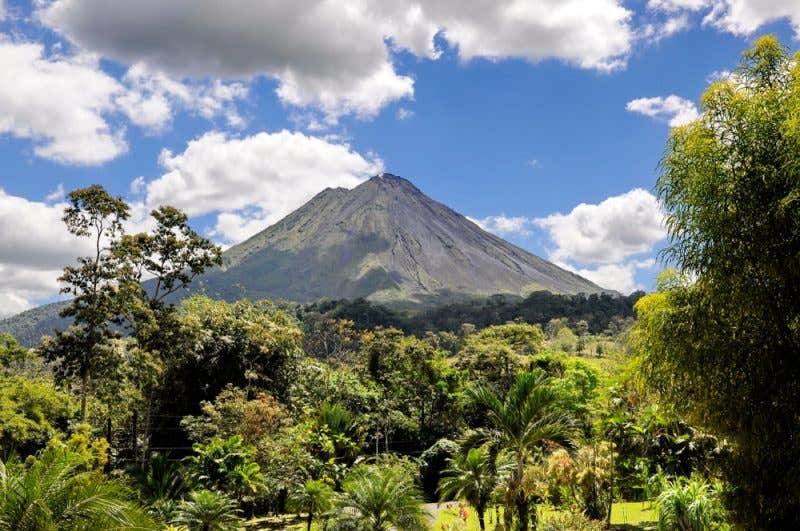Trees can provide early warning of volcanic eruptions, NASA finds
Scientists use satellite imagery of tree leaves to predict volcanic eruptions, offering safer early warnings globally.

Trees near volcanoes become greener as carbon dioxide rises underground, providing an unexpected early warning system through satellite monitoring. (CREDIT: Shutterstock)
Volcanoes often give little warning before they erupt, but now scientists have discovered an unexpected early warning sign—trees. This new finding comes from a joint study by researchers from NASA, the Smithsonian Institution, and various universities who have shown that changes in tree leaves can indicate rising volcanic activity. More importantly, satellites can spot these changes, potentially providing a safe, cost-effective way to predict volcanic eruptions.
How Trees Warn Us About Volcanic Activity
Volcanic eruptions begin deep beneath Earth's surface, as magma pushes upward. This magma releases gases, primarily carbon dioxide, before reaching the surface. Unlike sulfur dioxide, which satellites detect easily, volcanic carbon dioxide often blends in with the atmosphere, making it tough to track from space. However, trees near volcanoes respond visibly to this gas, becoming greener and healthier.
According to volcanologist Robert Bogue from McGill University, carbon dioxide emissions from volcanoes directly influence nearby vegetation. "The whole idea is to find something we could measure instead of carbon dioxide directly," Bogue explained, "to give us a proxy to detect changes in volcano emissions."
By absorbing the volcanic carbon dioxide, trees enhance their photosynthesis process. This leads to noticeable greening, detectable through satellites. Researchers use a tool called the Normalized Difference Vegetation Index (NDVI), which measures leaf health based on reflected light captured from orbiting satellites like NASA’s Landsat 8 and ESA’s Sentinel-2.
Satellites Unlock Early Warnings
Historically, scientists needed to physically visit volcanoes to measure carbon dioxide levels, a task both dangerous and costly, especially in remote regions. Satellite imaging eliminates these risks. Nicole Guinn, a volcanologist from the University of Houston, led a groundbreaking study at Mount Etna in Italy. Her team matched satellite data with on-ground carbon dioxide sensors and found a strong connection between higher carbon dioxide emissions and greener leaves.
During their study, researchers observed 16 distinct spikes in carbon dioxide emissions linked to magma movements beneath Mount Etna. These movements correlated with measurable increases in NDVI, demonstrating the potential of satellites to accurately track volcanic activity through vegetation changes.
Related Stories
Despite the promising results, the approach has limitations. Not all volcanoes have enough nearby trees, and factors such as weather, forest fires, or plant diseases can obscure satellite data. However, the method provides an essential complement to traditional monitoring techniques like seismic waves and ground deformation.
Field Validation Strengthens Satellite Data
To confirm satellite data accuracy, scientists conducted field tests around the active Rincon de la Vieja volcano in Costa Rica. Josh Fisher from Chapman University led these efforts, collecting leaf samples and directly measuring carbon dioxide levels near volcanoes.
Fisher’s team discovered that trees' responses to volcanic carbon dioxide emissions can also help scientists predict how vegetation worldwide might react to future increases in atmospheric carbon dioxide. "We're interested not only in tree responses as an early eruption warning," Fisher stated, "but also in how much carbon dioxide trees can absorb, offering insight into Earth’s ecological future."
Practical Benefits and Global Implications
Globally, volcanic threats affect about 10% of the population, making improved eruption warnings critical. Traditional monitoring methods, including on-site sensors, cover only about 2% of active volcanoes. The ability to track volcanic activity remotely through tree changes means scientists can provide early warnings to regions lacking direct monitoring infrastructure.
Florian Schwandner from NASA’s Ames Research Center has seen firsthand how crucial early warnings can be. In 2017, his team added carbon dioxide and sulfur dioxide sensors to Mayon Volcano in the Philippines. These sensors helped evacuate over 56,000 people safely before a major eruption in January 2018, preventing casualties.
"No single signal from volcanoes is a silver bullet," Schwandner emphasized. Yet, the remote sensing of tree greenness provides another powerful tool. "This could really change the game," he added.
Unlocking the Science Behind Tree Responses
Scientific studies have long confirmed that increased carbon dioxide promotes plant growth. FACE (Free-Air Carbon Dioxide Enrichment) experiments proved plants thrive under higher carbon dioxide, enhancing photosynthesis and leaf starch content.
Similar results emerged from volcanic areas, like Mammoth Mountain in California and Furnas Caldera in the Azores, where vegetation clearly responded to volcanic carbon dioxide exposure.
Scientists also found that excessive volcanic carbon dioxide could damage or kill trees. In 1990, an eruption at Mammoth Mountain suffocated tree roots with carbon dioxide-rich soil gas, creating visible "kill zones." Such cases show that trees’ responses to volcanic gases vary significantly, highlighting the complexity of using vegetation as a universal monitoring tool.
Expanding the Reach of Volcanic Monitoring
Mount Etna serves as an ideal testing ground because of its extensive monitoring network and diverse forest types, including beech and oak. Continuous monitoring there demonstrated consistent relationships between carbon dioxide emissions and tree health, making it possible to apply this remote sensing approach to other volcanoes worldwide.
While more research is necessary to address remaining challenges, the ability to remotely monitor volcanic activity through tree health signals is revolutionary. It provides a cost-effective, safe, and globally accessible early warning method, potentially saving thousands of lives.
"Volcanoes are notoriously unpredictable," Bogue acknowledged, but "trees might just give us the warning we need."
Note: The article above provided above by The Brighter Side of News.
Like these kind of feel good stories? Get The Brighter Side of News' newsletter.



